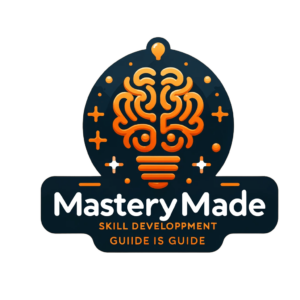In our pursuit of academic excellence, we recognize the pivotal role of effective learning methods in shaping not only our grades but also our overall understanding. We’ve all experienced the daunting task of efficient exam preparation, where it feels like there’s an ocean of knowledge to absorb and an ever-ticking clock. But fear not, as we delve into study techniques that promise to elevate our learning game and turn those long hours into a series of successful study sessions.
Join us, as we unravel the secrets to mastering the art of learning, ensuring every minute spent with our books translates into progress. Together, we can turn the tide of tedious cramming into a strategic, structured approach that not only prepares us for exams but also instills in us a lifelong passion for learning.
Key Takeaways
- Discover the transformative impact of adopting effective learning methods.
- Understand the significance of tailoring study techniques to fit personal learning styles.
- Learn how efficient exam preparation can be more than just reading pages after pages.
- Grasp the benefits of structured study plans and organized learning environments.
- Explore the power of innovative study tools and strategies that facilitate memory retention and understanding.
Understanding the Basics of Effective Learning Methods
Embarking on the journey of academic success begins with a solid understanding of effective learning methods. It’s about more than just hitting the books—it requires a strategic approach that caters to individual strengths and preferences. Let’s delve into the core aspects of study strategies that set the stage for academic success.
Identifying Your Personal Learning Style
Every student’s brain ticks a bit differently. Recognizing whether you’re a visual, auditory, reading/writing, or kinesthetic learner can transform your study sessions from fruitless to fruitful. Visual learners might benefit from diagrams and color-coded notes, while auditory learners could prefer listening to recorded lectures or discussing topics out loud. For those who learn best through reading/writing, detailed notes and summaries are key, whereas kinesthetic learners thrive on hands-on experiences and movement. As we explore each learning style in-depth, you’ll discover tips that resonate with your unique cognitive landscape, ultimately enhancing your study strategies.
Building a Conducive Learning Environment
Just as a plant needs the right environment to grow, your study habitat can significantly impact your learning efficiency. A tranquil, organized space—free from distractions and tailored for comfort—can facilitate better focus and information retention. We’re talking about more than just a tidy desk; it’s about the ambiance, too. Proper lighting that reduces eye strain, an ergonomic chair to support your posture, and some peaceful background music, if that’s your cup of tea, are all parts of crafting an ideal learning environment. By suggesting adjustments to your study space, we aim to help you create an atmosphere where concentration thrives and productivity blossoms.
Setting Achievable Study Goals
To avoid feeling overwhelmed, setting SMART goals can be a game-changer for your academic journey. Specific, Measurable, Achievable, Relevant, and Time-bound objectives create a roadmap, guiding you through your material step by step. By breaking down your goals into digestible tasks, and assigning realistic deadlines to each, time management for studying becomes second nature. We’ll go over examples of SMART goals tailored for different subjects, showcasing how this technique streamlines your learning process.
In addition to these foundational elements, mastering various note-taking techniques is crucial for effective time management and capturing key information. Whether you use the Cornell method, mind maps, or the outline system, your notes are your allies in the battle against time constraints and overwhelming course content. We’ll offer insights on each method to help you pick and practice the one that complements your learning style, ensuring your notes aren’t just scribbles, but a powerful study tool.

- Visual Learning Aids: Charts, infographics, and flashcards
- Auditory Techniques: Repeating information aloud and using mnemonic devices
- Reading/Writing Exercises: Summaries and bullet-point lists
- Kinesthetic Activities: Applying the learned concepts through practice or teaching others
By weaving together these study strategies, note-taking prowess, and time management tactics, you’re setting yourself up for a successful and productive learning experience. Let’s ensure your academic efforts are as efficient and rewarding as possible.
Effective Study Techniques for Enhancing Retention
Embarking on a journey to improve memory retention is a pivotal step towards academic excellence. We recognize the importance of embracing active learning techniques that not only facilitate information absorption but ensure longevity in its recall. Transforming your study habits into a more engaging process defines the essence of our approach. Strategic methodologies like spaced repetition and active recall have stood the test of time as effective memory retention techniques. Let’s delve into these concepts and adjust our study routines for optimum learning outcomes.
Utilizing Spaced Repetition
Spaced repetition is an empirical system, designed to promote retention of new information by revisiting it at strategic intervals. The core principle here is to leverage the psychological spacing effect, whereby intervals between subsequent review sessions increase over time. By practicing spaced repetition, we encourage our brains to fortify the neural connections associated with the learned materials, thus enhancing recall capabilities. Integrating this technique into our study regime can be straightforward and highly beneficial.

Implementing Active Recall in Your Study Routine
Active recall is a foundational element of active learning, positioning us to actively engage with the material rather than passively absorb it. This technique challenges us to retrieve information from memory without the aid of notes or books. It’s a form of self-testing that propels our brains to reconstruct learnt concepts, thereby strengthening memory retention. When we combine active recall with spaced repetition, we create a robust framework for securing knowledge long-term.
| Technique | Definition | Benefits | Practice Tips |
|---|---|---|---|
| Spaced Repetition | Revising information at increasing intervals of time | Enhances long-term memory retention | Schedule study sessions on a calendar with progressively longer gaps |
| Active Recall | Testing oneself to retrieve information without cues | Strengthens recall and understanding | Use flashcards, practice problems, or teach the material to someone else |
We’ve explored some compelling techniques that you can easily incorporate into your study habits. Adopting both spaced repetition and active recall will significantly boost the efficacy of your learning process. Make your study sessions count by ensuring that each moment spent is an investment towards solidifying your grasp of the material. Start integrating these methods today, and you’ll soon see a noticeable difference in how swiftly and effectively you can retrieve information when you need it most.
Mastering Time Management for Studying
As we continue to delve into effective study techniques, it’s essential that we turn our attention to the element of time management. In our journey to offer the best study tips, we’ve identified that managing time efficiently is not just beneficial but imperative for academic success. It is about making the most of each minute and avoiding the stress of last-minute cramming. Let us share how you can harness time management to enhance your learning experience.
Firstly, creating a study schedule is akin to building a roadmap for your academic journey. It provides structure and ensures that every subject or topic receives the attention it deserves within your available time. Consider your peak productivity hours when you’re the most focused and alert. Reserve these for studying the most challenging subjects, as this is when your brain is most capable of complex thought processes.
Procrastination is often the arch-nemesis of effective studying. We encourage you to tackle assignments or revision as soon as they’re assigned, which reduces the anxiety associated with a looming deadline. To aid in this process, setting incremental goals for each study session can be tremendously helpful. Seeing progress, no matter how small, can be a significant motivator.
Finding balance ensures that while your study demands are met, your personal life doesn’t fall by the wayside. Breaks are also critical to avoid burnout. We recommend the Pomodoro Technique, a time management method that uses a timer to break work into intervals, traditionally 25 minutes in length, separated by short breaks.
| Time of Day | Activity | Duration | Focus Level |
|---|---|---|---|
| Morning | Review Notes | 1 Hour | High |
| Afternoon | Research & Reading | 2 Hours | Medium |
| Evening | Practice Problems | 1.5 Hours | Medium-High |
Lastly, we cannot overstate the power of delegation. For topics that are extensive and complex, breaking down the material into manageable sections allows for a deeper understanding and retention of the information. By systematically studying each segment, the knowledge becomes part of your long-term memory, thus mastering not just the content but also how you manage the study time it requires.
In conclusion, mastering time management for studying is not just about crossing off tasks on a to-do list; it’s about creating a sustainable approach that enables effective learning and long-term academic endurance. Embrace these techniques, and watch as your academic prowess grows alongside your ability to navigate the inevitable challenges of time management.
Incorporating Active Learning into Your Study Sessions
As we delve into the realm of active learning, it’s vital to explore how engaging directly with educational content can dramatically enhance your retention and understanding. Integrating hands-on, study strategies not only fortifies your grasp of the material but also transforms the very nature of your study sessions into a more dynamic and interactive experience. Let’s dive into some of the most effective forms of active learning.
Participating in Study Groups for Collaborative Learning
Forming or joining study groups offers a multitude of benefits. By participating in group discussions, you’re exposed to diverse perspectives and interpretations of the subject matter. Such interactions can help clarify complex topics and fill learning gaps through peer explanations. Let’s outline the advantages:
- Discussion of different viewpoints enhances critical thinking.
- Opportunities to teach peers solidify your own knowledge.
- Group accountability keeps you motivated and on track.
Additionally, engaging in intellectual dialogue within a study group encourages the consolidation of concepts, because as you articulate your thoughts, you’re being actively involved in the learning process.
Applying Knowledge through Practice and Teaching Others
Nothing tests your understanding of a concept better than applying it in real-world scenarios or teaching it to someone else. When you communicate what you’ve learned, you’re not just regurgitating facts; you’re actively processing the information and relating it to what you already know. This approach is one of the cornerstones of active learning. Here’s how you can put it into action:
- Engage in practical exercises that are relevant to the study material.
- Take on the role of a teacher by explaining topics to peers or study buddies.
- Create hypothetical scenarios where you can apply your knowledge.
Bearing in mind these strategies, active learning can become an integral part of your study sessions, leading to a deeper understanding and a more enriched educational experience.
| Passive Learning Strategies | Active Learning Strategies |
|---|---|
| Reading textbooks without engagement | Creating flashcards and quizzes |
| Listening to lectures without participation | Joining study groups and discussions |
| Copying notes verbatim | Teaching materials to others |
| Completing assignments without reflection | Applying concepts in practical exercises |
Conclusion
In the journey through academia, we’ve explored and acknowledged the sheer breadth and depth of effective learning methods that can transform our study routines and lead to efficient exam preparation. As we venture to the end of this discussion, let’s encapsulate the fundamental essence of what we’ve learned. By understanding and embracing our unique learning styles, we can tailor our study techniques to suit our needs best, facilitating a conducive environment for academic success.
The strategies surveyed have underscored the importance of active engagement with the material through study groups and real-world application, proving that learning is a multi-dimensional process. Through intentional practice, such as spaced repetition and active recall, we enhance our capacity to retain information over longer periods. Moreover, by mastering time management for studying, we ensure that every moment spent delving into textbooks and lectures is one step closer to our goals.
In summation, the commitment to actively adopting diverse study strategies positions us at the vanguard of our academic aspirations. It is our diligent application of these techniques that will shape our future success. We encourage you to stand at the helm of your educational experience, navigate with these principles, and watch as your proficiency in learning and preparing for exams reaches new, unprecedented heights.
FAQ
What are some effective study techniques for exam preparation?
Effective study techniques for exam preparation include spaced repetition, active recall, practicing on past exam papers, and teaching the material to someone else. Adopting these methods can help reinforce the knowledge and ensure better retention and understanding.
How can identifying my personal learning style improve my studying?
Knowing your personal learning style—be it visual, auditory, reading/writing, or kinesthetic—allows you to tailor your study methods to suit how you learn best. This customization can make your study sessions more efficient and effective.
What are some good note-taking techniques to enhance learning?
Effective note-taking techniques include the Cornell Method, Mind Mapping, the Outlining Method, and the Boxing Method. Each technique helps in organizing information systematically, making it easier to review and remember the key points.
How can I build a conducive learning environment?
A conducive learning environment is quiet, free from distractions, and has good lighting and comfortable furniture. It’s also beneficial to have all the necessary supplies on hand and to personalize your space in a way that inspires you to study.
Why is time management important for studying and how can I improve it?
Good time management allows you to study more effectively by allocating dedicated time to each subject or topic, preventing procrastination, and ensuring a balanced approach to studying and personal responsibilities. Using tools like planners, apps, or the Pomodoro Technique can significantly enhance your time management skills.
Can you explain what spaced repetition is and how it aids in memory retention?
Spaced repetition is a learning technique that involves reviewing information at increasing intervals over time. It leverages the psychological spacing effect, which suggests that we remember things better when our study sessions are spread out, preventing the forgetting curve and boosting long-term retention.
What is active recall and how does it contribute to more effective studying?
Active recall is a practice where you test yourself on the material you’re trying to learn, rather than passively re-reading or highlighting text. It forces your brain to retrieve the information and has been shown to significantly improve memory and the learning process.
How can participating in study groups enhance my learning?
Study groups can enhance learning by allowing you to gain new perspectives, openly discuss and challenge concepts with peers, and reinforce your understanding by explaining material to others. They also offer motivation and support from fellow students.
Why is teaching others an effective way to solidify what I’ve learned?
Teaching others requires you to organize your thoughts and explain concepts in a clear and concise way, which can reveal any gaps in your knowledge. The process often results in a deeper understanding and better retention of the information.
What are SMART study goals and how do I set them?
SMART study goals are Specific, Measurable, Achievable, Relevant, and Time-bound. To set SMART goals for studying, define what you need to achieve with as much detail as possible, decide how you’ll measure progress, ensure the objective is realistic, ascertain its relevance to your overall academic aspirations, and set a deadline for completion.











